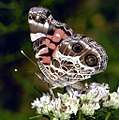American lady
The American painted lady or American lady (Vanessa virginiensis)[1] is a butterfly found throughout North America.
| American painted lady | |
|---|---|
 | |
| Scientific classification | |
| Kingdom: | Animalia |
| Phylum: | Arthropoda |
| Class: | Insecta |
| Order: | Lepidoptera |
| Family: | Nymphalidae |
| Genus: | Vanessa |
| Species: | V. virginiensis |
| Binomial name | |
| Vanessa virginiensis (Drury, 1773) | |
| Synonyms | |
| |
The larvae feed on various Asteraceae, such as the cudweeds (genus Gnaphalium), the pussytoes (Antennaria), and the everlastings (Anaphalis), which all belong to tribe Gnaphalieae.[2] All stages of the life cycle can be found throughout temperate North America as well as Madeira and the Canary Islands. Occasionally individuals can be found as far as southwest Europe.
Description
Vanessa virginiensis is most easily distinguishable by its two large eyespots on the ventral side, whereas V. cardui has four small eyespots and V. annabella has none. V. virginiensis also uniquely features a white dot within the forewing subapical field, set in pink on the underside and usually also in the dorsal side's orange field.
The largest spot in the black forewing tips is white in V. cardui, pale orange in this species, and orange in the West Coast species. The latter also has a purer orange background color of the dorsal side, as opposed to the darker and (especially in V. virginiensis) redder hue of the other two.
A less reliable indicator is the row of black eyespots on the dorsal submarginal hindwing. In the American painted lady, those on the opposite ends of the row are often larger and have blue "pupils". In V. annabella, this applies to the inner two spots, while in V. cardui some of the black eyespots may have tiny blue pupils in the summer morph, but usually have none at all, and the eyespots themselves are all roughly the same size. The size of the wings are about 5 cm (2 in) across.
Distinguishing features
Gallery
 Underside of wings
Underside of wings Some individuals lack the additional white subapical forewing spot
Some individuals lack the additional white subapical forewing spot Ventral side
Ventral side- Adult resting on a flower
 American lady butterfly caterpillar in Wooster, Ohio, United States
American lady butterfly caterpillar in Wooster, Ohio, United States
References
- "Vanessa Fabricius, 1807" at Markku Savela's Lepidoptera and Some Other Life Forms
- "Species Vanessa virginiensis - American Lady - Hodges#4434". BugGuide.
| Wikimedia Commons has media related to Vanessa virginiensis. |
- Riley, N.D. and Higgens, L.G. 1970. A Field Guide to the Butterflies of Britain and Europe. Collins, Great Britain. ISBN 0-00-212028-3
See also
External links
- American Lady on the UF / IFAS Featured Creatures Web site
- American Lady, Butterflies of Canada